Four-day fête celebrates new BAMPFA, opening Sunday
UC Berkeley's $112 million visual arts center has a prime location in the Berkeley Arts District
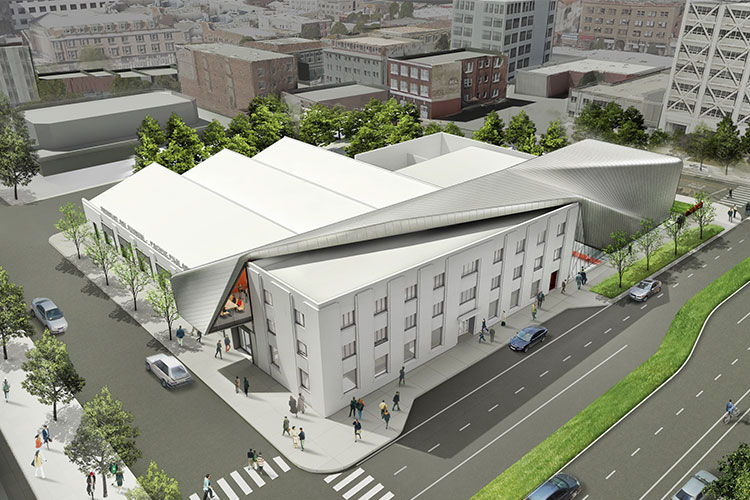
January 25, 2016
The new Berkeley Art Museum and Pacific Film Archive — with its fresh design, expanded programs and prime town-and-gown location — is about to be celebrated with a four-day grand opening that starts this Thursday, Jan. 28, and culminates in a free public open house on Sunday, Jan. 31.
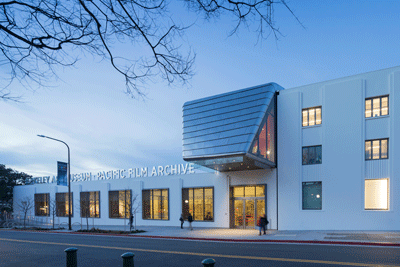
BAMPFA’s Center Street façade (Photo by Iwan Baan, courtesy of Diller Scofidio + Renfro, EHDD and BAMPFA)
A “creative black tie” gala and personalized tours for students, museum members and donors are among the scheduled Grand Opening Week events. Community Day, on Sunday, will run from 11 a.m. to 11 p.m. and include exhibits, films, music and hands-on art-making. The event is free for all, but reserving a timed ticket via the BAMPFA website is encouraged.
UC Berkeley’s new $112 million visual arts center is an 83,000-square-foot architectural wonder at the intersection of Oxford and Center streets, in the heart of the growing downtown Berkeley Arts District. It was designed by New York-based Diller Scofidio + Renfro, an international design firm known for creatively connecting institutions to a wider urban and public context.

BAMPFA’s outdoor screen on the Addison side of the building (Photo by Iwan Baan, courtesy of Diller Scofidio + Renfro, EHDD and BAMPFA)
Under one roof, BAMPFA now houses versatile exhibition galleries, two film theaters, a performance forum, a café, four study centers for art and film, a reading room and an art-making lab. The building also features a large, outdoor LED screen and viewing area for public screenings. BAMPFA’s new location places it close to BART, the campus and in the heart of downtown Berkeley.
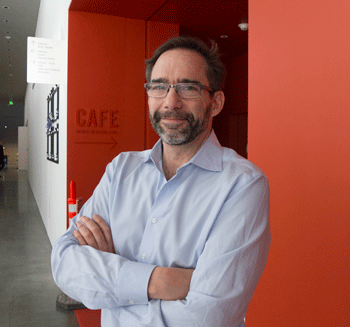
Larry Rinder, director of BAMPFA (BAMFA photo by Peter Cavagnaro)
“BAMPFA’s versatile new home, situated at the intersection of campus and community, will provide unparalleled opportunities for our diverse audiences to engage with art and film more deeply than ever before,” says Larry Rinder, BAMPFA’s director. “We are thrilled to be part of the dramatic revitalization of downtown Berkeley.”
New offerings for the public at BAMPFA include Family Fare, a program that connects art-making with viewing art in the galleries; free admission to the galleries for kids 18 and under plus one adult; an expanded number of film screenings – 450 annually — at the 232-seat Barbro Osher Theater; a performance series, Full, which takes place on the night of each new full moon; evening gallery hours and lunchtime gallery talks with UC Berkeley professors.
Sustainable reuse
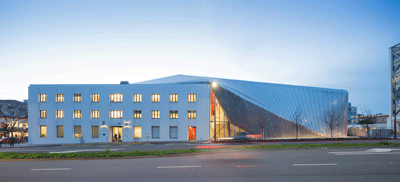
The Oxford Street façade with 1939 Art Deco administrative building at left and new stainless steel-clad structure at right (Photo by Iwan Baan, courtesy of Diller Scofidio + Renfro, EHDD and BAMPFA)
An adaptive reuse of the former UC Berkeley printing plant — a 48,000-square-foot Art Deco building — BAMPFA is a blend of old and new, dramatic and serene. The exterior, for example, features a striking, sculptural form of curved, brushed stainless steel that extends from the cantilevered second-story café to the film theater and outdoor screen. This new form echoes the curvilinear lines of the Deco style while framing the 1939 building’s clean, white forms.
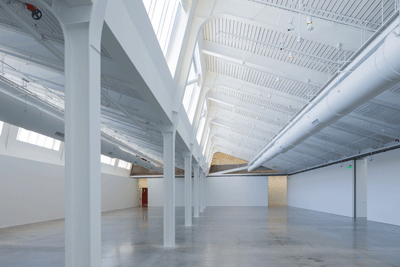
BAMPFA’s largest gallery, with restored sawtooth roof and beam above (Photo by Iwan Baan, courtesy of Diller Scofidio + Renfro, EHDD and BAMPFA)
In the interior, the elegant, well-proportioned galleries range in size from an intimate room for focused exhibitions to vast, nearly 10,000-square-foot galleries incorporating the printing plant’s dramatic north-facing skylights. Areas painted chili-red contrast with cool, polished concrete floors and the warmth of wood. Using reclaimed wood, some of it salvaged from Canary Island pine trees removed to make way for construction, master woodworker Paul Discoe built stepped seating in the performance forum and created wood features for the admissions desk and store.
The hip, architecturally mind-bending Babette café, which cantilevers over Center Street, offers patrons views toward downtown Berkeley and the west entrance to campus, as well as indoor glimpses of the museum’s galleries.

Street-level window glazing illuminates an interior special event space (Photo by Iwan Baan, courtesy of Diller Scofidio + Renfro, EHDD and BAMPFA)
From outside, passersby on Center Street can look through the ample front windows to see the Art Wall, a 60-by-25-foot interior surface where leading international artists, commissioned biannually by BAMPFA, will create large-scale murals.
Rotating through the art galleries — for which admission is free for BAMPFA members, UC Berkeley students, staff, faculty and retirees, and anyone 18 and under — will be a varied program of exhibitions covering a wide spectrum of cultures and periods. The museum will feature exhibitions highlighting works from its extensive collection of more than 19,000 works of art that stretch from 3,000 B.C.E to the present. Among the important holdings are Neolithic Chinese ceramics, Italian Baroque paintings, abstract Impressionist paintings, Old Master works on paper and contemporary photography.
Arts + Design Initiative
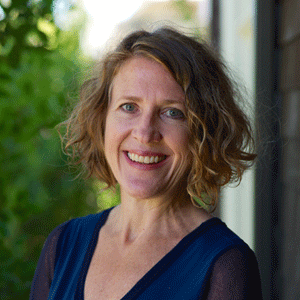
Shannon Jackson, associate vice chancellor for the arts and design (Photo courtesy of Arts + Design Initiative)
BAMPFA is part of a major effort under way at Berkeley to raise the profile of the arts and creative design across campus and to engage more students in these fields, no matter their academic major.
Led by UC Berkeley’s first associate vice chancellor for the arts and design, Shannon Jackson, the Arts + Design Initiative further embeds creativity into existing curricular and extracurricular learning while deepening the campus’s strong connection to a wider Bay Area arts ecology.
BAMPFA’s opening exhibition, Architecture of Life, is an example of this venture. A new undergraduate Big Ideas course inspired by the Jan. 31-May 29 exhibition is a no-experience-assumed immersion in how to connect thinking, watching, listening and making on campus.
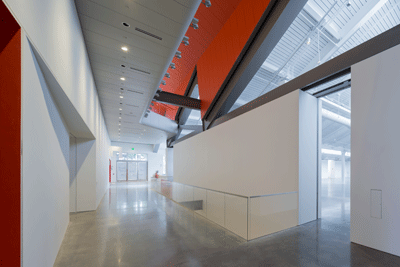
The main corridor of BAMPFA, looking south toward the public entrance on Center Street (Photo by Iwan Baan, courtesy of Diller Scofidio + Renfro, EHDD and BAMPFA)
Taught by Jackson and professor Nicholas De Monchaux, the course includes lectures at the museum for students on Mondays and free lectures on Wednesdays that are open to both students and the public. The Thinking Across the Arts and Design at Berkeley: The Architecture of Life course includes free tickets for students to campus musical, dance and theater performances in Zellerbach Hall and Zellerbach Playhouse.
“The new BAMPFA will be transformative for UC Berkeley,” says Jackson. “It affords a passage from the city to the university, opening the door to dozens of cultural activities throughout campus. By embedding a public lecture series inside our new course on the Architecture of Life, we seek to heighten the student experience of the arts while also serving a wider intergenerational public in the region.”
The Arts + Design Initiative also supports Chancellor Nicholas Dirks’ dedication to enhancing the undergraduate experience at Berkeley by placing a priority on the arts and design, which he sees as essential to a well-rounded education and beneficial to students’ quality of life and academic performance.

Interior view of the BAMPFA multipurpose event space and mezzanine, with the underside of the theater (Photo by Iwan Baan, courtesy of Diller Scofidio + Renfro, EHDD and BAMPFA)
“University art museums today no longer are ancillary to the mission of higher education, but central — even foundational — to it,” says Dirks. “Experiences with visual art are now understood to significantly benefit students’ quality of life and their academic performance. The material and intellectual richness of BAMPFA will be invaluable to students as they pursue a Berkeley liberal arts education across many disciplines.”
A forward-looking history
The campus’s first art museum, Bacon Hall, opened in 1881, and some works in BAMPFA’s collection date from the founding of what may have been the first art museum on the West Coast.
The museum in its recent incarnation opened in 1963 and was launched with a gift to the campus by German abstract expressionist artist Hans Hoffman of 47 of his own paintings and $250,000 toward construction of the Bancroft Way building. The campus’s Powerhouse Gallery, near Sproul Plaza, housed the museum’s activities until the new facility was complete.
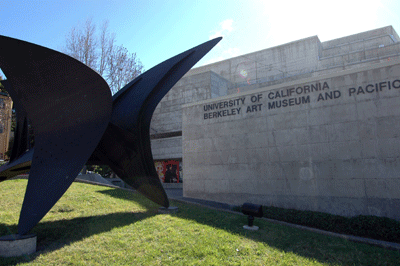
A 2005 photo of UC Berkeley Art Museum on Bancroft Way (UC Berkeley photo by Bonnie Azab Powell)
In 1970, the University Art Museum, as BAMPFA then was called, opened a new building on Bancroft Way. Designed by Mario Ciampi, it was considered architecturally progressive for its time. Known since 2011 as Woo Hon Fai Hall, the museum had dramatic, angular, cast concrete walls; a full-height, sky-lit hollow center and non-traditional, tiered exhibit spaces. Poets Gary Snyder and Richard Brautigan and the Anna Halprin Dancers were among the guest artists during the opening weeks.
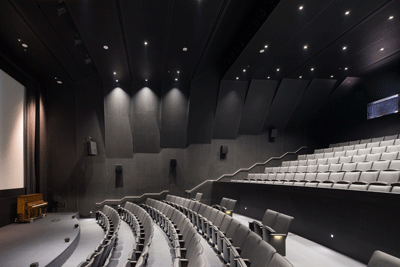
The new Barbro Osher Theater, with acoustics that allow BAMPFA to screen a variety of film formats with top-level clarity and sound (Photo by Iwan Baan, courtesy of Diller Scofidio + Renfro, EHDD and BAMPFA)
A theater opened in the University Art Museum in 1971 to house the programs of the Pacific Film Archive and held a three-day celebration of international and experimental cinema.
In 1996, University Art Museum was renamed the UC Berkeley Art Museum and Pacific Film Archive (BAM/PFA).
In 1997, BAM/PFA’s Bancroft Way home was deemed seismically unsafe and unable to be retrofitted in a way that would not compromise the galleries. Temporary seismic retrofitting was installed on the interior and exterior, and film screenings were moved to the Hearst Field Annex across Bancroft Way. The university-owned site where the new BAMPFA is about to open was identified as the best location for a new facility that again would unite the gallery and film programs.
BAMPFA team
Design architect: Diller Scofidio + Renfro
Executive architect: EHDD General
Contractor: Plant Construction Co.
Project management: UC Berkeley Construction & Design
“We look forward to welcoming visitors from the campus, community and all corners of the globe to discover fresh experiences of art and film from around the world,” says Rinder. “At BAMPFA, our mission is to inspire the imagination and ignite critical dialogue through art and film. At our new home, we will be able to do this better than ever.”